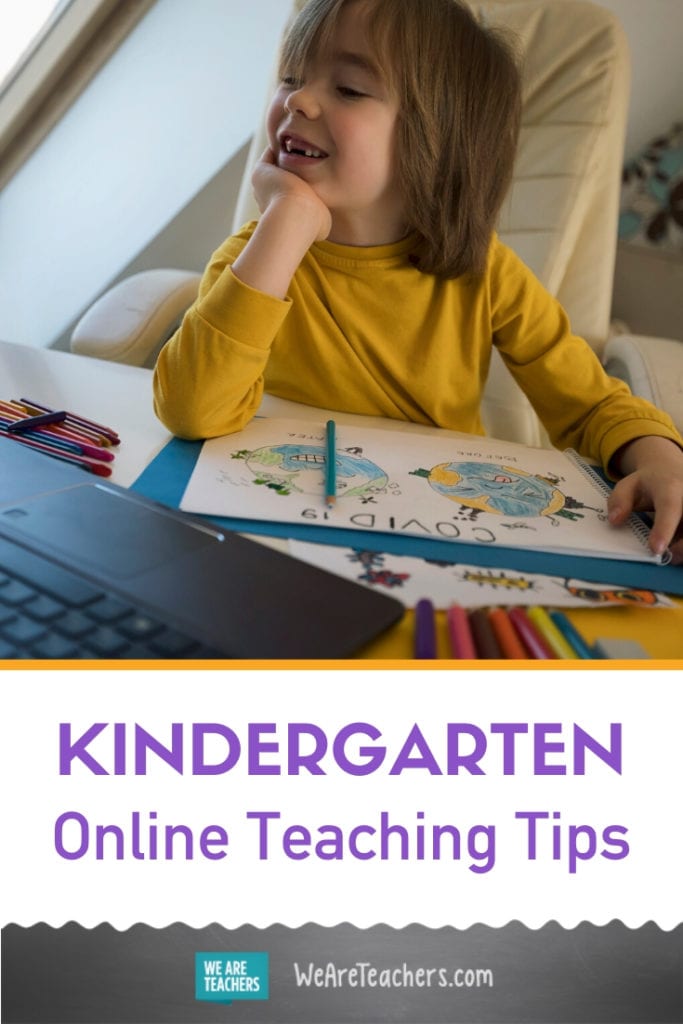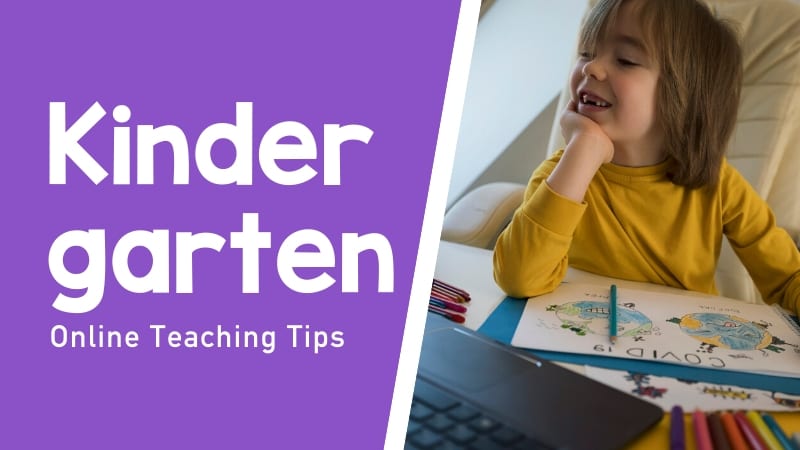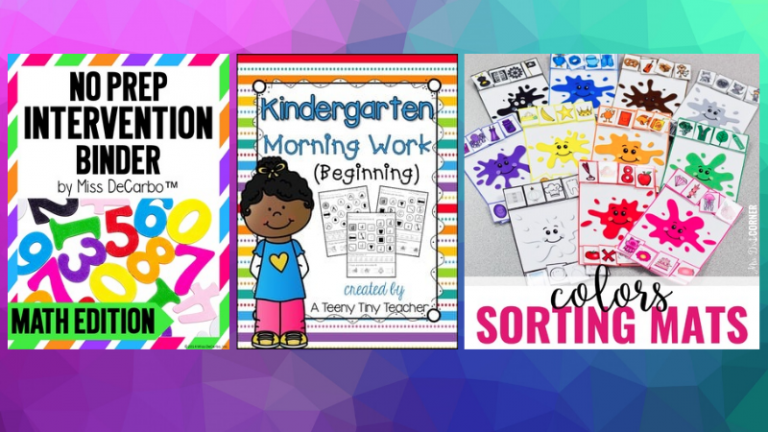What a joy to teach Kindergarten! For many children, this is their first year at school and they greet each day at school with curiosity, innocence, and delight. Kindergartners are devoted, young learners brimming with observations about every math concept, read-aloud, science experiment, and phonics lesson you present. However, their unfamiliarity with school routines, literal interpretation of the world, and dependence on adults, can make teaching kindergarten online learning seem like a daunting task. If you’ve looked around to consider what resources might help, you’re probably pretty overwhelmed. We hear you, so we curated practical kindergarten online teaching tips from teachers who are doing their best to be there for students:
Get Ready and Prepared
1. Be there for yourself so you can be present for them
While all students learn best from teachers who are calm, centered, and present, this is especially crucial in a kindergarten classroom. For many teachers, entering their classroom in the morning, updating the daily schedule, and organizing the day’s lesson materials are key ways they shift into teaching mode.
At home, switching from home mode to teaching mode might be a bit harder. That’s why it’s essential to create a dedicated space for teaching and establish a consistent teaching routine. Begin by setting up your space with your favorite teaching tools and objects. Many teachers use a corner of a bedroom, an extra card table, or a shared desk in a home office. Size doesn’t matter. It’s the idea of having a designated space and place to keep all your supplies together that’s important. You need to feel this space is your classroom, and that when you arrive, it’s time to teach.
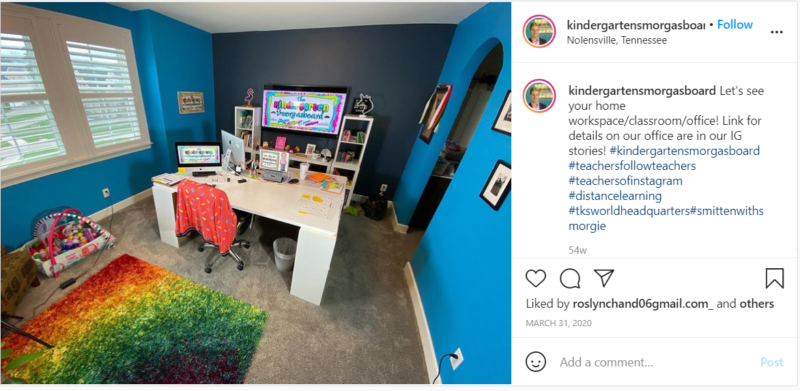
Source: @kindergartensmorgasboard
2. Know thy kindergartner
While all children develop at their own unique pace, let’s discuss the typical kindergartner. These 5-6 year olds are eager to explore, full of questions, and will master new skills quickly with steady guidance from caring adults. They enjoy routines and structure and benefit from clear instructions that take into account their very literal understanding of the world around them. Kindergartners need frequent check-ins and ample encouragement as they tackle the new academic and social-emotional challenges of school. They enjoy helping and following the rules, but often cry when upset, confused, or embarrassed.
Physically, kindergartners are better at gross motor skills like running and jumping than younger children, but may still be awkward when it comes to small motor skills. They are very energetic, noisy, and will have trouble staying in their seat for long periods of time. Fine motor skills and hand-eye coordination are still developing at this age, so kindergartners may have trouble printing.
In terms of cognitive development, kindergartners like to learn through hands-on experiences and repetition. They often have difficulty seeing more than one way to complete a task and may also struggle to see things from another’s point of view. They ask many questions and are generally very interested in learning and following directions. Kindergartners enjoy dramatic play, interactive learning, singing, and movement.
[contextly_auto_sidebar]
3. Join a kindergarten teacher Facebook group
You’re not the only one navigating online learning, so don’t go it alone—join a group! While every home and school situation is different, online groups can be a good way to build a community of support and to find your teaching people. Just think of it as your online teacher’s lounge. Here are some Facebook groups you might want to check out:
- Simply Kinder
- Time 4 Kindergarten
- International Kindergarten Teachers Unite!
- Miss Megan’s Camp Kindergarten
- Primary Teachers
Set Up Your Online Classroom
4. Keep an online classroom where everything is organized
Now that you’re ready with your physical space, it’s time to tend to your online classroom. Your district or school may have chosen the platform for you, in which case, stick with it. Parents and kids need to hear a consistent message, so doing it differently might cause confusion.
If you do get to create your own online classroom, keep in mind that it should have the same essential elements as your physical classroom including a place to post assignments, a library of resources, an assignment inbox, and student communication tools. There is an abundance of virtual learning platforms from which to choose.
If your kindergarten hasn’t been using a Learning Management Systems (LMS) from the start, you’ll need to set it up and consider the best ways to teach how to use it. Many teachers have found that the best way to help students get used to the system is to begin with low-stakes, fun tasks to complete using the LMS.
5. Choose an online video conferencing program, if you are able
During times of online learning, video conferencing can be a powerful way to support young learners and nurture a sense of community. Many schools or school districts choose a video conferencing tool for teachers to use. If you get to choose your own platform, Google Meet and Zoom are popular choices.
Keep in mind that some families may need greater flexibility in their child’s online learning schedule, so avoid requiring students to attend all video conferences. For some teachers, video conferencing with students is not allowed by their school or district. Always follow your school’s guidelines as appropriate.
Source: Diary of a Not So Wimpy Teacher
6. Try a threaded discussion chat
Kids need a predictable structure for how to connect and ask questions. So, if you are unable to do video chats or don’t want to do them every day, try a threaded discussion chat. Try discussion boards like Google Classroom, Blackboard, and Canvas. Another one of our favorite discussion board apps is Padlet.
7. Have set office hours for kids to reach out to you
The simpler you can make it for your students to reach out to you, the less frustration your students and their families will feel while navigating online learning. Having regular office hours also helps students feel that you are there for them when learning online.
Manage Your Classroom
8. Engage kindergartners online based on their development
You’ve got the platforms and systems in place. Now it’s time to actually manage the classroom online. Here are a few quick initial tips:
- Break down assignments into manageable parts and be prepared to break them down into even smaller chunks during online learning.
- Give short, clear instructions, and check in frequently with students to make sure they understand your directions.
- Take regular movement breaks and create opportunities for students to socialize.
- Stick to predictable daily and weekly schedules.
- Provide opportunities for repetition of songs, rhymes, and games throughout the day and throughout the week.
- Give frequent positive and specific reinforcement to all students.
9. Use your previous lesson plans and pacing guide, but prepare to adapt
Many of your kindergartners will be starting their first year in elementary school, and many will also be learning to use online tools for the first time. Go slowly. Re-evaluate your lesson plans to include time for students to log in, open documents, start video calls, and complete other technology setup tasks. Looking for ways to strategically avoid time pressures will help reduce frustrations for you and your students.
Keep in mind that your pacing guides were developed for an in-person classroom setting. It’s awesome if you make it all the way through, but you may also need to slow down if it seems like students are struggling. It can feel like a lot to learn new tools on top of adjusting to every day kindergarten school routines. Patience, a willingness to experiment, and a bit of humor may be required as you and your students adapt to online learning.
10. Be consistent about your routines
Building predictable, consistent systems in your online classroom will help your kindergartners feel comfortable and confident in this new learning environment. Start slowly. At first, keep one simple document with hyperlinks that students can reference and click on to get to the different things they need each day. Weekly checklists can also be an effective way to keep students accountable for assignments while making it easy for parents to know what to expect too.
After you’ve set up standards for where to find things and what’s expected, you can transition to assigning and collecting student work through the LMS and set up your video or threaded message chats there. Ask your students for regular feedback about what’s working and what isn’t. You may need to experiment with a few different organizational strategies before finding the one that’s just right for you and your class.
11. Encourage independence
Most kindergartners will look to their teacher for guidance on how, where, and when to complete an activity, and then need additional support once they begin their work. Online learning often demands that students become more independent in their learning, so make time to talk about this challenge. Invite students to think about, and plan for, how they will be successful learners at home. This could include collaborating with a parent to organize their own learning space and gather essential school supplies. Kindergartners crave approval from adults, so provide frequent positive and specific encouragement whenever you see them engaging in independent learning.
12. Let kindergartners do their favorite thing—repeat, repeat, repeat
Again! Again! Kindergartners delight in repetition in the form of songs, rhymes, chants, and games. Repetition also helps boost their confidence and their understanding of new concepts. Creating online audio or video recordings using a smartphone or your computer makes it easy for your kindergartners to enjoy all the replays they want without you losing your voice. Families will also appreciate having a resource bank of familiar activities students can enjoy independently.
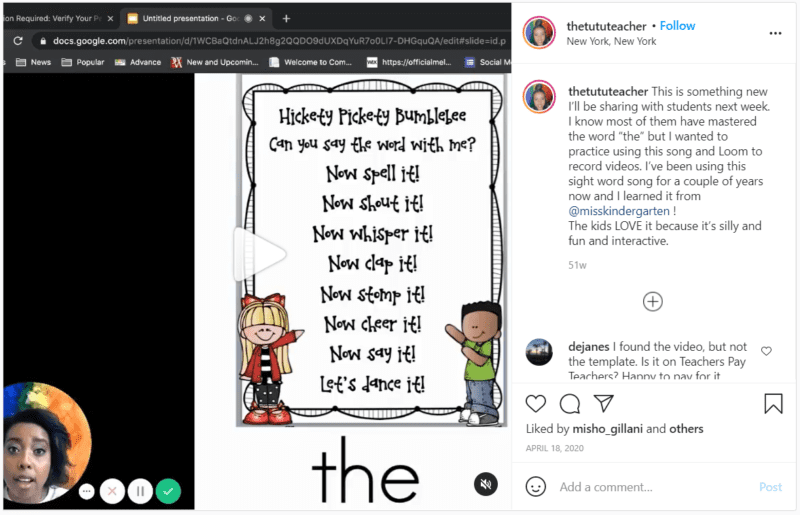
Source: @thetututeacher
13. Prioritize student communication & collaboration
Kindergartners need consistent support and guidance from their teacher. Even with clear instructions, they always have questions and will benefit from getting answers from you quickly so they can keep going. They’re also used to having your help staying organized and on task. These needs aren’t going to change. If you prioritize student communication, collaboration, and interaction, the quick feedback will reap the benefit of more connected students.
14. Manage online classroom behaviors
In the typical kindergarten classroom, students are adjusting to school routines, learning to navigate interactions with classmates and forging a connection with their teacher. Expect online learning to add a few extra skills to master and some new behaviors to manage. Set aside time to coach your students on becoming responsible online learners. Outline clear expectations and review them frequently. Make a plan for how you will respond to distractions, rudeness or other inappropriate behavior.
Many teachers have found it helpful to make a Google slide or PDF document with illustrations and text that outline expected behavior for video conference calls. This free PBIS guide to remote learning behavior can help you put your plan into action. Being intentional about grouping (versus selecting groups randomly) can also help keep some classroom behaviors in check.
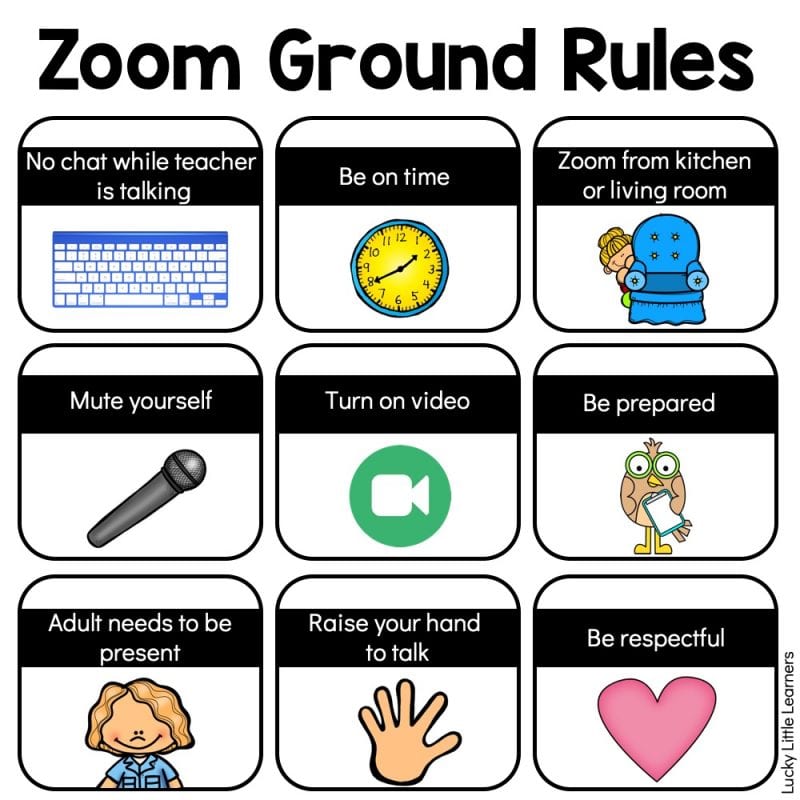
Source: Lucky Little Learners
Add To Your Classroom
15. Create your own videos when the topic is more difficult
During online learning, family schedules may prevent students from logging on for every video lesson. Recording your own videos not only allows students to see that you are still there for them, but also creates a bank of resources for your repetition-loving kindergartners. Keep video lessons short (no more than 5 minutes) especially at the beginning of the year. Upload these videos to the LMS and add assignments to supplement the material. Students can watch the videos when they can and review them as needed while working on assignments.
16. Use these online tools that work particularly well with kindergartners
- Boom Cards: Digital task card activities in reading, phonics, math, science, and social studies that kids can do independently.
- Flipgrid: This short video response platform makes it fun for everyone to participate.
- Teach Your Monster to Read: Fun phonic game that covers everything from letters and sounds to reading full sentences.
- Storyline Online: Students can listen to a variety of high-quality stories read aloud.
- Seesaw: Students can create digital portfolios of their work that are easy to share with families.
17. Try some games suited to kindergarten sensibilities
Let’s play! Games are a great way for students to build community while also getting their wiggles out. Movement activities that support the development of gross motor skills, such as yoga and dance, are especially beneficial for kindergartners. Online videos from GoNoodle can help get your class up and dancing in no time. Other popular games for kindergarten include Simon Says, rhythm chants, and simple scavenger hunts that invite students to bring something to share at morning meeting. Scavenger hunts could include finding a common household object or something that fits a certain category (yellow, red, soft, hard, tasty, yucky, etc.).
18. Explore these kindergarten resources to add depth to your lessons
Feeling a bit overwhelmed with resources? Then take a break and come back to these later. When you’re ready, you’ll find everything you need to keep your eager and active kindergartners engaged and learning online.
- 50 Great Books for Kindergarten
- 40 Kindergarten Art Projects That Inspire Creativity in Every Student
- 16 Awesome Kindergarten Blogs and Teachers to Follow
- Khan Academy’s Kindergarten Math
- Wonderful Websites, Games and Learning Activities for Kindergarten
- BrainPOP Jr.
- Kindergarten Math, Language Arts, and Science Videos
- 21 Anti-Racism Videos to Share with Kids
- 60+ Awesome Websites for Teaching and Learning Math
- Wonderopolis
- Creative Ways Teachers Are Building Classroom Community Online
- DK Find Out!
What are your favorite kindergarten online teaching tips? Please share in the comments!
Plus, don’t forget to sign up for our weekly emails to receive more ideas!
Looking for more ways to connect to your kindergartners? Check out 350+ Amazing Online Learning Resources!
